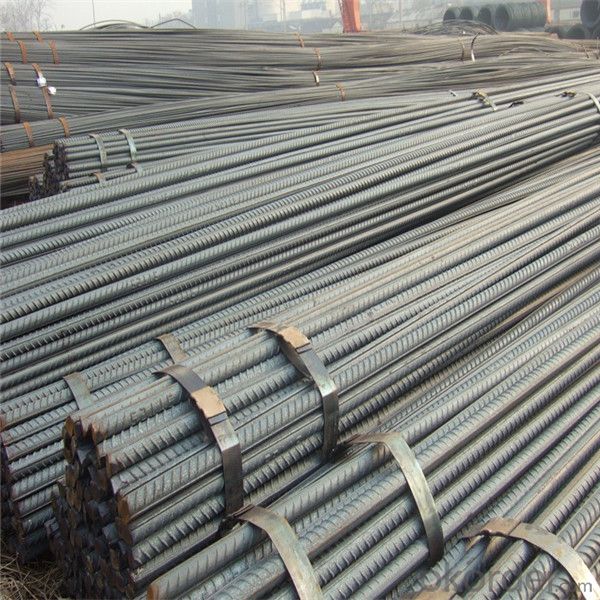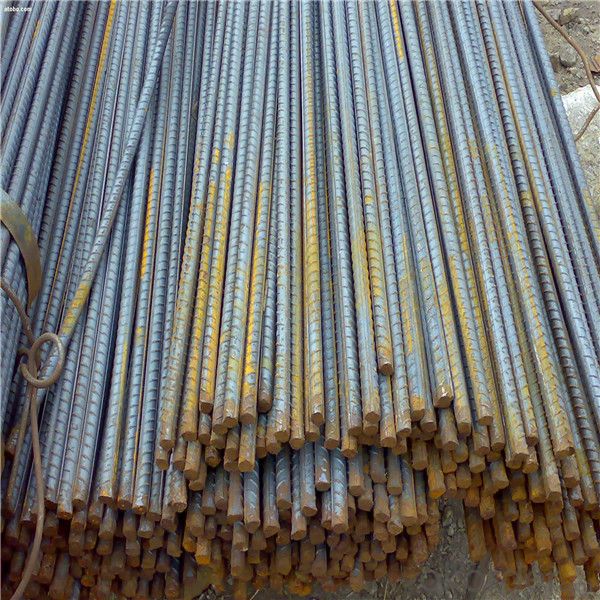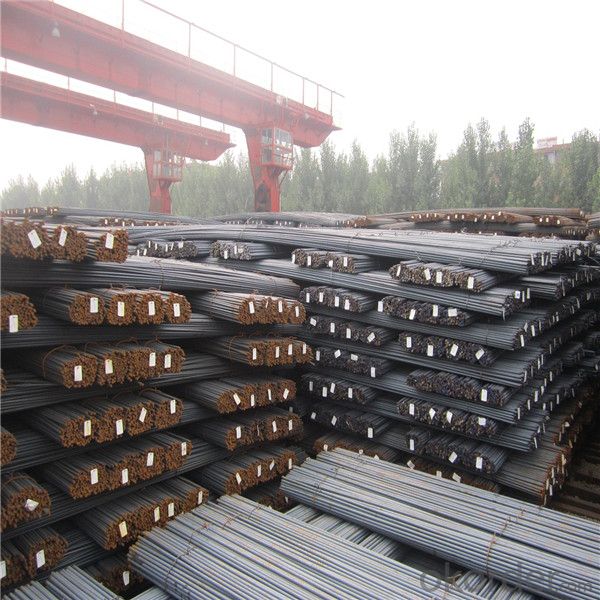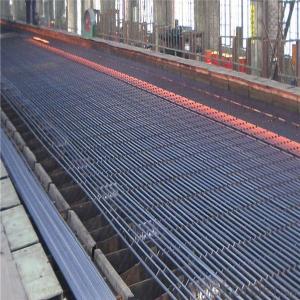Steel Rebars prices per ton for building construction
- Loading Port:
- Tianjin
- Payment Terms:
- TT OR LC
- Min Order Qty:
- 100 m.t.
- Supply Capability:
- 18000 m.t./month
OKorder Service Pledge
OKorder Financial Service
You Might Also Like
Item specifice
Common rebar is made of unfinished steel, making it susceptible to rusting. As rust takes up greater volume
than the iron or steel from which it was formed, it causes severe internal pressure on the surrounding concrete,
leading to cracking, spalling, and ultimately, structural failure. This is a particular problem where the concrete is
exposed to salt water, as in bridges built in areas where salt is applied to roadways in winter, or in marine applications.
Epoxy-coated rebar or stainless steel rebar may be employed in these situations at greater initial expense, but significantly
lower expense over the service life of the project. Fiber-reinforced polymer rebar is now also being used in high-corrosion environments
Our Advantage: High quality steel products from 1 class mills in China
Reasonable price
Professionalism of the products
On-time delivery
Complete documents and certificates
Sincere service to meet our clients' requirements
Product Description :
Chemical composition (%): | Steel | C | Si | Mn | P | S | Ceq | ||||
HRB335 |
0.25 |
0.80 |
1.60 |
0.045 |
0.045 | 0.52 | |||||
HRB400 | 0.54 | ||||||||||
HRB500 | 0.55 | ||||||||||
Mechanical properties | Steel | Rel/ MPa | Rm/ MPa | A/ % | Agt/ % | ||||||
≥ | |||||||||||
HRB335 | 335 | 455 | 17 |
7.5 | |||||||
HRB400 | 400 | 540 | 16 | ||||||||
HRB500 | 500 | 630 | 15 | ||||||||
Package: | Standard export packing or as customer's request | ||||||||||
Application: | Construction, building, bridge, road. ect | ||||||||||
Payment terms | 1).100% irrevocable L/C at sight. | ||||||||||
Delivery time | 15-30 days after receipt of L/C or deposit by T/T | ||||||||||


Packing:
In bundles, each bundle weight 3.5 tons. Load by container or by bulk verssel.


Our service
(1) We cooperate with famous factories with advanced equipment and well trained workers.
(2) We can provide factory price with trading company service.
(3) We continuously work on the improvement of our processes, guaranteeing consistently high standards
of quality to keep none compensation.
(4) We guarantee 24 hours response and 48 hours solution providing service.
(5) We accept small order quantity before formal cooperation.
(6) We deliver the agreed quality at the agreed time, reacting to changes in customer wishes in a flexible way.
(7) Due to our volume and selling power, we have excellent freight rates with shipping lines.
(8) We strive to always be fair and honest in our dealings with customers.
(9) We strive to work together with customers to achieve much more than we can achieve alone.
(10) Through our passion and commitment we aim to be a market leader in all our key markets. To maintain
our position as market leader we must continue to add value in all that we do.
FAQ:
1.Q: What's your MOQ(minimum order quantity)?
A: One full container, mixed acceptable .
2. Q: What's your packing methods?
A: Packed in bundle or bulk ..
3. Q: How can I buy CNBM products in my country?
A:Please send us an inquiry or email ,we will reply to you if there is distributor in your country
4. Q: Can we visit your factory?
A: Warmly welcome. Once we have your schedule, we will arrange the professional sales team to follow up your case.
5. Q: How long does it take to get the product if i place an order?
A:With the process of your requirements,we will pack and deliver in 3-7 days. If it is by sea shipment,it will take 15-45 days depending on different locations
- Q:What are the guidelines for the proper anchoring of steel rebars in walls?
- The guidelines for proper anchoring of steel rebars in walls typically involve factors such as the rebar size, spacing, embedment depth, and the type of wall construction. It is important to follow building codes and structural engineering standards specific to your region. Generally, rebars should be adequately spaced and securely anchored into the surrounding concrete or masonry to ensure proper load transfer and structural integrity. Additionally, proper cover thickness should be maintained to protect rebars from corrosion and ensure long-term durability.
- Q:What are the precautions to be taken while welding steel rebars?
- When welding steel rebars, there are several precautions that need to be taken to ensure safe and effective welding: 1. Proper ventilation: Welding generates fumes and gases that can be harmful if inhaled. Therefore, it is important to work in a well-ventilated area or use exhaust systems to remove the fumes and maintain a safe breathing environment. 2. Personal protective equipment (PPE): Welders should always wear appropriate PPE, including a welding helmet or face shield, safety glasses, welding gloves, flame-resistant clothing, and steel-toed boots. This protective gear helps minimize the risk of burns, eye injuries, and other physical hazards. 3. Fire prevention: Welding involves intense heat and sparks, which can ignite flammable materials. Before starting the welding process, ensure that the work area is clear of any combustible materials, and have a fire extinguisher nearby. It is also advisable to have a fire watch person present to monitor the area for any potential fire hazards. 4. Grounding: Proper grounding is essential to prevent electrical shocks during welding. Ensure that the welding machine is properly grounded, and the workpiece is connected to a reliable grounding point. 5. Preparing the surface: Before welding, the surfaces of the rebars should be clean and free from any oils, grease, dirt, or rust. Use a wire brush or grinder to remove any contaminants, as they can affect the quality of the weld. 6. Welding technique: Employing the correct welding technique is crucial for achieving strong and reliable welds. Follow the recommended welding parameters, such as the appropriate current, voltage, and electrode diameter, to ensure optimal results. It is also important to maintain a steady hand and a consistent travel speed to prevent weld defects. 7. Training and experience: Welding steel rebars requires skill and knowledge. Ensure that the welder is properly trained and experienced in working with rebars. This will help minimize errors and ensure that the welds meet the required standards and specifications. By adhering to these precautions, welders can significantly reduce the risk of accidents, injuries, and subpar weld quality when working with steel rebars.
- Q:Can steel rebars be used in other applications besides construction?
- Yes, steel rebars can be used in other applications besides construction. They are commonly utilized in various industries such as automotive, manufacturing, and infrastructure projects, where their high strength and durability make them suitable for reinforcement purposes. Additionally, steel rebars can also be employed in sculptures, art installations, and DIY projects due to their malleability and versatility.
- Q:What are the guidelines for the proper spacing of steel rebars in beams?
- The guidelines for the proper spacing of steel rebars in beams are determined by engineering standards and codes. These guidelines ensure the structural integrity and strength of the beam. Here are some general guidelines to consider: 1. Rebar spacing: The spacing between rebars should be such that it allows for proper concrete placement and consolidation. Typically, the spacing is measured in terms of rebar diameter or as a percentage of the beam depth. The specific spacing requirements may vary based on factors such as the beam size, load requirements, and design specifications. 2. Minimum and maximum spacing: There are usually minimum and maximum spacing requirements for rebars in beams. The minimum spacing ensures proper concrete cover around the rebar to protect it from corrosion and provide fire resistance. The maximum spacing helps in distributing the loads evenly and prevents excessive cracking of the concrete. 3. Concrete cover: The rebars should be adequately covered by concrete to provide protection against corrosion and provide fire resistance. The concrete cover is the distance between the outer surface of the rebar and the edge of the beam. The required concrete cover is specified in engineering codes and is based on factors such as exposure conditions, durability requirements, and fire ratings. 4. Spacing around supports and openings: Special attention should be given to the spacing of rebars around supports such as columns and walls, as well as around openings like doorways or windows. These areas may experience higher stresses and require additional reinforcement. Engineering codes provide specific requirements for these situations, taking into account the size and shape of the supports or openings. 5. Lateral and longitudinal reinforcement: In addition to the spacing of rebars along the length of the beam (longitudinal reinforcement), beams may require additional reinforcement in the form of stirrups or ties (lateral reinforcement). These elements provide resistance against shear forces and help in preventing diagonal cracking. The spacing and size of these additional reinforcement elements are determined based on the design requirements and load conditions. It is important to note that the specific guidelines for spacing of steel rebars in beams may vary depending on regional building codes, project specifications, and engineering standards. Therefore, it is crucial to consult with a qualified structural engineer or refer to the applicable building codes and design documents for accurate and up-to-date guidelines.
- Q:What is the difference between the actual weight and the actual weight of the steel thread?
- Is the difference between the work and the theory of weight. General steel factory, have weight difference, unlike canned beverage, not so accurate, this is called "bad" or "inferior". But the mills are not stupid, only under the poor, is not Quejinshaoliang, with a significant difference (such as standard 100KG, he will give you a 110KG).
- Q:Can steel rebars be used in historical monument conservation?
- Yes, steel rebars can be used in historical monument conservation. They can be used to reinforce and strengthen the structures of historical monuments, ensuring their long-term stability and preservation. However, it is important to use appropriate and compatible materials to maintain the authenticity and historical integrity of the monument. Proper planning, expertise, and consultation with conservation experts are crucial in determining the best approach for incorporating steel rebars in historical monument conservation.
- Q:Can steel rebars be painted or coated for aesthetic purposes?
- Yes, steel rebars can be painted or coated for aesthetic purposes. The paint or coating helps enhance the appearance of the rebars and can also provide additional protection against corrosion.
- Q:How are steel rebars measured?
- Steel rebars are measured using a standardized system known as the "bar size number." This system assigns a numerical value to each rebar size, which corresponds to the diameter of the rebar. The diameter is measured in inches or millimeters, depending on the region or country. In the United States, the bar size number is used, which ranges from #3 to #18. The number indicates the diameter of the rebar in eighths of an inch. For instance, a #3 rebar has a diameter of 3/8 inch, while a #8 rebar has a diameter of 1 inch. Beyond #8, the diameter is measured in quarters of an inch. For example, a #11 rebar has a diameter of 1 1/8 inches, and a #18 rebar has a diameter of 2 1/4 inches. In metric countries, rebars are measured using millimeters. The diameter is typically rounded to the nearest millimeter. For instance, a 10 mm rebar is equivalent to a #3 rebar in the US, and a 25 mm rebar is equivalent to a #8 rebar. To measure the length of a rebar, a tape measure or ruler is used. The length is typically measured in feet or meters. Rebars are commonly available in lengths of 20 or 40 feet (6 or 12 meters), but they can also be cut to custom lengths as per project requirements. It is important to note that the measurement system may vary slightly in different regions or countries, so it is crucial to consult local standards and codes for accurate measurement guidelines.
- Q:Can steel rebars be used in structures with high resistance to vibration?
- Structures with high resistance to vibration can indeed make use of steel rebars. These rebars are frequently employed as reinforcements in concrete structures to enhance their durability and strength. The inclusion of steel rebars bolsters the structural integrity of buildings and infrastructure, rendering them more impervious to a range of forces, including vibrations. Steel rebars possess exceptional tensile strength and stiffness, enabling them to evenly distribute and absorb applied loads throughout the structure. This characteristic helps to minimize concentrated stress points that may trigger vibrations or structural failure. Moreover, steel rebars are effective in controlling crack widths and preventing crack propagation, which further fortifies the structure against vibrations. Furthermore, steel rebars can be tailored to meet specific requirements based on projected vibration levels. By utilizing rebars with suitable diameters, spacing, and anchorage details, structures can be engineered to withstand vibrations caused by various external factors, such as earthquakes, wind loads, or nearby machinery. It is of utmost importance to ensure proper design and detailing of steel rebars in structures with high resistance to vibration. The layout of reinforcements must be meticulously planned to account for anticipated forces and vibrations. Additionally, the rebars should be adequately anchored and connected to other structural components to maintain their efficacy in combatting vibrations. All in all, when designed and implemented correctly, steel rebars serve as a dependable and widely-used reinforcement material that significantly enhances the resistance of structures to vibrations.
- Q:Can steel rebars be used in cold storage construction?
- Yes, steel rebars can be used in cold storage construction. Steel rebars are widely used in construction due to their high strength and durability. In cold storage construction, where low temperatures are maintained, steel rebars offer several advantages. Firstly, steel rebars have excellent thermal conductivity, which allows them to quickly adjust to the low temperatures inside the cold storage facility. This helps in maintaining a consistent temperature throughout the structure and prevents any potential expansion or contraction issues. Secondly, steel rebars have a high tensile strength, making them suitable for withstanding heavy loads and providing structural stability in cold storage construction. The cold storage facility often requires a strong framework to support the weight of products and equipment stored within. Furthermore, steel rebars are corrosion-resistant, which is particularly important in cold storage environments. The low temperatures and high humidity levels can create a favorable environment for corrosion. However, steel rebars are typically coated with epoxy or galvanized to protect them from moisture and prevent rusting. Lastly, steel rebars are readily available and cost-effective, making them a practical choice for cold storage construction projects. They can be easily sourced and fabricated to meet specific design requirements, ensuring that the structure is built to withstand the unique challenges of a cold storage environment. In conclusion, steel rebars can be effectively used in cold storage construction due to their thermal conductivity, high tensile strength, corrosion resistance, and availability. They provide the necessary structural support and durability required for the construction of cold storage facilities.
1. Manufacturer Overview |
|
|---|---|
| Location | |
| Year Established | |
| Annual Output Value | |
| Main Markets | |
| Company Certifications | |
2. Manufacturer Certificates |
|
|---|---|
| a) Certification Name | |
| Range | |
| Reference | |
| Validity Period | |
3. Manufacturer Capability |
|
|---|---|
| a)Trade Capacity | |
| Nearest Port | |
| Export Percentage | |
| No.of Employees in Trade Department | |
| Language Spoken: | |
| b)Factory Information | |
| Factory Size: | |
| No. of Production Lines | |
| Contract Manufacturing | |
| Product Price Range | |
Send your message to us
Steel Rebars prices per ton for building construction
- Loading Port:
- Tianjin
- Payment Terms:
- TT OR LC
- Min Order Qty:
- 100 m.t.
- Supply Capability:
- 18000 m.t./month
OKorder Service Pledge
OKorder Financial Service
Similar products
New products
Hot products
Hot Searches
Related keywords




























